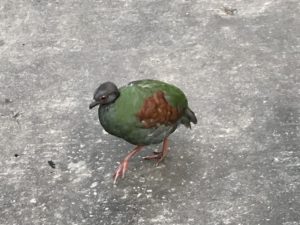Cornwall, in far southwest England, is home to the world’s largest indoor rain forest — and I had a chance to see it in late 2018.
I was traveling with a number of American travel agents, all of us hosted by VisitBritain and a tour operator, Avanti Destinations.
The Eden Project, site of the indoor forest and lots of other biological wonders, was our first stop in Cornwall.
This project was envisioned, beginning in the 1990s, as a place to show in dramatic and graphic ways the interdependence of life on Earth and, by extension, our need to protect and live responsibly with Earth’s plants and animals.
More succinctly, it’s an eco park with an educational purpose. It also is entertaining, and it is a charity.
Its address is in a hamlet called Bodelva. This is a few miles away from St. Austell, one of Cornwall’s largest towns with a population of around 20,000.
The Eden Project covers 35 acres and is home to more than a million plants.
It sits in a reclaimed china-clay pit, and its most distinguishing features are the domes that cover two large biospheres, one filled with rain forest plants and some birds and one focused on Mediterranean types of environments.
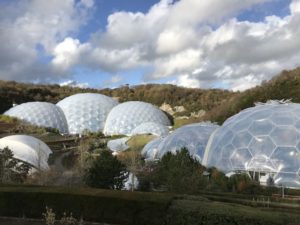
The Eden Project’s two biospheres. The set of domes at left covers the indoor rain forest, while the set at right encompasses Mediterranean types of environments. The white structure at lower left is site of the project’s stage.
Also, there is artwork all over the place, rather rustic pieces in that they are made of wood, sometimes wood that, to my eyes, seemed not to have been cut or shaped before being incorporated into artworks.
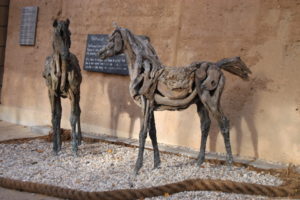
On the Eden Project grounds, two horses created from driftwood by artist Heather Jansch. They stand in front of a rammed earth wall, meaning a wall made of earth (clay, gravel, sand and silt) that was pounded into position. Some interiors of China’s Great Wall are of rammed earth, too, BTW.
The complex also includes a stage and an arena to accommodate all sorts of events produced for locals and visitors. Further, in winter, the stage is an ice rink.
The Eden site also boasts England’s longest and fastest zipline. I have traveled ziplines in a seated position, but these lines transport riders horizontally and face down for fly-by views of the biosphere domes and more at the Eden Project.
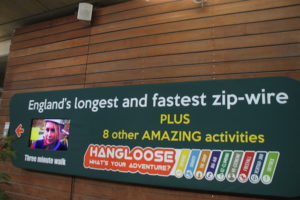
The Eden Project offers a range of physical activities for the more adventurous visitors, including a very fast zipline ride.
The project’s Web site describes other adventures, including a 12-meter/39-foot jump (“finding your inner stuntman”) and a 10-meter/31-foot leap from a cliff’s edge.
I don’t have an inner stuntman.
Anyway, for our markedly more subdued crowd, we had a guide, Thomas, who narrated visits to parts of both biospheres.
One of the more amazing sights: the seed for the coco de mer palm, the world’s largest seed (about 20 inches in diameter). The plant, which originates in the Seychelles, also has the largest palm fronds.
And, here is a striking info fragment that reflects the project’s educational theme: Thomas said 70% of agricultural land feeds the First World, and people in the rest of the world are dependent on the remainder.
And, here’s a considerably less consequential factoid: Lemongrass expels pests. I wonder if that works with bugs in the home?
In my photos, I have charming middling-sized birds, identified as roul-roul partridges from Malaysia.
We concluded with a visit to a building called Invisible Worlds and the name is descriptive.
One exhibit was a huge ceramic monument dedicated to cyanobacteria, the tiny and still-extant life form that gave us oxygen many eons ago. Our very existence depended on these small creatures!
The ceramic invention is designed to replicate the processes that yielded that first oxygen on Earth. Complex and mind bending — and beyond my comprehension.
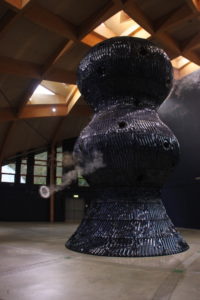
Inside a building called Invisible Worlds, a huge ceramic monument to cyanobacteria, a tiny bacteria that gave us oxygen many eons ago. The ceramic piece, called “Blue,” is designed to replicate the processes that create oxygen.
Visitors are expected to spend a lot more time at the Eden Project than our group of travel professionals did. (Travel agents and tour operators on educational journeys tend to see everything in small bites in order to cover tons of territory in a few days.)
Eden Project entry fees are £28.50 for adults; £26 for seniors (age 60+); £23.50 for students, and £15 for ages 5 to 16. There are modest discounts for buying on line, but for green arrivals, all those prices are £4 less. A green arrival refers to arrival by foot, by bike or on public transport.
St. Austell Brewery
We closed out this day with a tour and samplings at the St. Austell Brewery in the town of St. Austell.
The brewery, founded in 1851, remains a family-owned business — and it is a large one. Our host said the company bottles 50,000 pints of beer per day and that it uses 10 million bottles a year. The company produces between 35 million and 36 million pints of beer annually, a lot of which is evidently distributed in barrels for pouring at pubs.
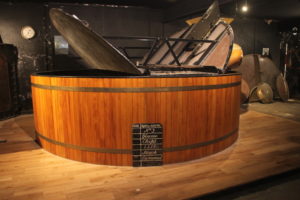
A nice big vat for beer, seen on the St. Austell Brewery tour. I am posting the photo partly because I like the look of the wooden exterior. I should have stood in it to illustrate the size, too.
Interestingly, some of the hops for St. Austell’s production come from the U.S., from California and, more often, from Willamette Valley in Oregon.
It is always an education, for me, to visit a brewery and listen to descriptions of how brewing works, but I don’t drink beer so the tastings are wasted on me.
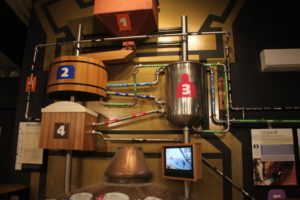
At St. Austell Brewery in Cornwall, this diagram illustrates the beer-making process and makes sense (to me) with a guide explaining it!
However, I mention the brewery for two reasons. First, anyone can visit (£15 for a tour with samplings; £25 for an extended tour, samplings and a Cornish pasty).
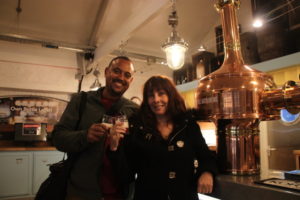
Sampling beers at the St. Austell Brewery, two of my travel companions, Ken Pringle, owner, Green Thumb Travel, Portland, Ore., and Marisabel Marty, business development manager, Travel Planners International, Maitland, Fla.
Second, there are those who may be interested in the brewery’s annual Celtic Beer Festival, held in autumn. This year’s event is set for Nov. 30.
For more information about Cornwall, we offer at BestTripChoices.com the following, under the headline, Pasties: A tasty tradition: https://besttripchoices.com/international-touring-areas/cornwall-england/
This blog and its photos are by Nadine Godwin, BestTripChoices.com editorial director and contributor to the trade newspaper, Travel Weekly. She also is the author of “Travia: The Ultimate Book of Travel Trivia.”

